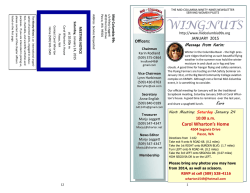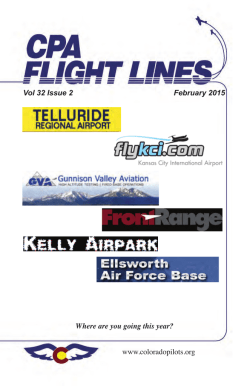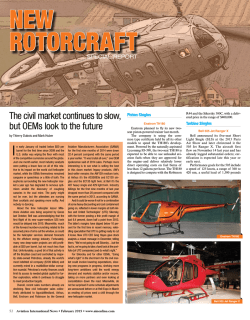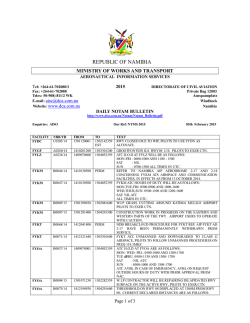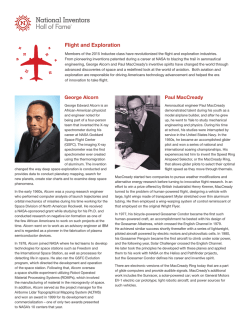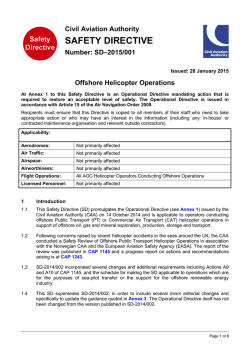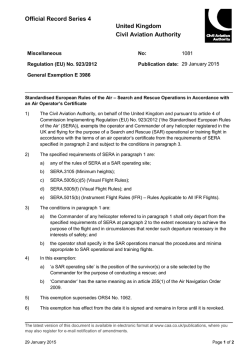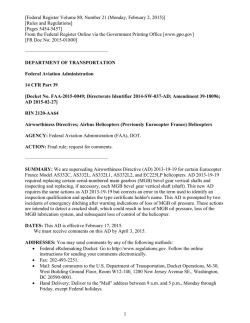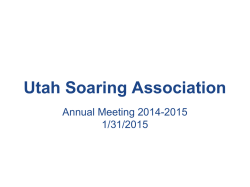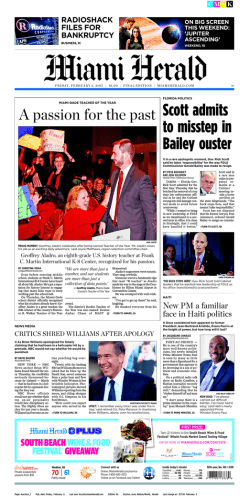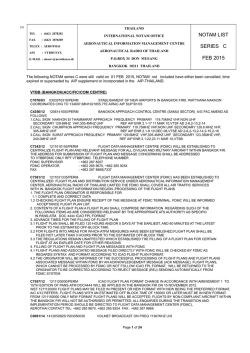
Plane Tales - Southwest Section Ninety
Chairman: Irene Engard 714-658-2624 Vice Chair: Pat Prentiss 951-533-3341 Past Chair: Rene’ Perrigoue OC99s website: http:\\oc99s.sws99s.org February 2015 Calendar of Events Feb 4 Feb 11 Mar 4 Business Meeting, Signature, 5:30pm General Meeting - 6:30 White Elephant Sale Business Meeting, Signature Mar 5-7 Women in Aviation, Dallas, TX Mar 11 General Meeting - Movie Night Mar 21 SBA Fly In April 1 - Business Mtg, Signature April 8 General Meeting—Ballooning Apr 30-May 3 SWS Meeting Temecula “Flying to the Stars” Registration & details: http://ninetynines.net/sws99sCC/ July 5-10 International Conference — Munich, Germany http://www.ninety-nines.org/index.cfm/conference.htm Secretary: Carol Bennett Treasurer: Lianne Oakes 949-212-5690 949-476-2572 OC 99s facebook page: facebook.com/OC99s WEDNESDAY FEBRUARY 11th IS WHITE ELEPHANT TIME! Join the Fun! Our White Elephant Sale is guaranteed to make you laugh while raising money for our chapter to support scholarships and educational activities. For those of you who are new to our chapter, a White Elephant is an idiom for a valuable but burdensome possession in search of a new home. Check your closets, drawers and attics. Ask friends and relatives for precious items ready to be re-homed. Do you have something fabulous that's not your size? Did you redecorate, leaving clashing things in your closet? Do you have two of something? Your gently used valuables will find someone to appreciate them. Wrap up a couple of your White Elephants; add a smartly labeled tag that will give a brief but mysterious description of the item. Poems are good for this. Take some time to create a rhyme so the Ninety-Nines can ponder your treasure of wonder. This gives our auctioneer (Pat Prentiss) just enough information to entice bidding. No wrapping paper? Pop goodies in grocery bags, or wrap in old charts. Funds short? No worries. Watch the fun and giggle along. Some items go for $2. Gather at 6:30, meeting at 7pm Home of Cynthia Jensen-McMullin 25472 Bootstrap Place, Laguna Hills, CA 92653 (directions on a following page) Refreshment Committee OUR MISSION --The Ninety-Nines is the International organization of women pilots that promotes advancement of aviation through education, scholarships, and mutual support while honoring our unique history and sharing our passion for flight. Would the following members be so kind to co-ordinate refreshments (or if they need to switch months) with Cheryl Cotman at 949-723-1097 no later than February 7th Diane Myers Lianne Oakes Therese Paul Kim Nobles Christine Olson Rene’ Perrigoue F Irene, Set to put a spin on 2015 at the HeliStream meeting. ebruary….Lincoln’s and Washington’s birthdays….Valentine’s day...Ground Hogs Day ….Super Bowl….Mardi Gras….my trip to New Orleans....Ash Wednesday....Chinese New Year….Tu Bishvat....International Condom Day (its true, I found it on the internet)....Academy Awards. How can we cram so many events into such a tiny month. To top it off, we are having our potentially raucous White Elephant Auction, the proceeds of which will help us support scholarships within the organization. What was once old is new again. This event gives all of us the opportunity to take a fresh look at “something old”. Beauty is in the eye of the beholder…..one woman’s trash is another’s treasure…..its all about perspective. Isn’t it true—how we look at or “see” things influences our lives everyday. How you look at and see our organization influences your interaction and involvement. I encourage you to take a fresh look by reserving your space at our Spring Section Meeting in Temecula. How fortunate we are to have the next Section event almost in our backyard. Come meet members from the five western states that make up our Section (CA-AZ-HI-NV-UT). We will have the opportunity to expand our aviation education and share our unique history with each other. We do good works and I want others to know about it….but I need your help. Take a minute and review your “Go for the Gold” worksheet. Mail or email your aviation related activities, or bring your sheet to the next meeting. Just a reminder of the goals I hope we accomplish as a Chapter this year (2015): Plan ahead and have at least 20 members attend the Spring Section meeting in Temecula. Serve our community and WIN the Public Relations and Aviation and Space Education Award (which will be awarded in Temecula and we will all be there to accept it). Mentor another member on the volunteerism side of our chapter. It would be very healthy for our chapter if at least two people knew how to create all the wonderful things we do. Irene Where did I put that extra trunk that needs to find a new home? I don’t want to be late to the meeting. Photo by Irene Engard—Serengeti—2008 Join us at our February meeting at the home of Cynthia Jensen-McMullin. We always have so much fun with our White Elephant night—and make money for the scholarships supported by the Chapter! 25472 Bootstrap Place, Laguna Hills, CA 92653 Exit I-5 on La Paz southwest. Cross Paseo de Valencia. Take the next left onto Gallup Circle. Drive up the hill, and turn right onto Bootstrap Place. If lost, call (949) 643-1086 ============================================================================================================= Member Skylar Lewis, who received her PPL in August, has just been accepted into MIT! Massachusetts Institute of Technology is often cited as among the world's top universities. It is traditionally known for research and education in the physical sciences, engineering, biology, economics, linguistics and management. It is extremely competitive for admission into MIT, so just being accepted is huge. We hope we get to see Skylar at a meeting while she finishes at Thacher High School in Ojai, or at least before she heads to MIT. We are so proud of you, Skylar! CONGRATULATIONS, SKYLAR! ~~~~~~~~~~~~~~~~~~~~~~~~~~~~~~~~~~~~~~~~~~~~~~~~~~~~~~~~~~~~~~~~~~~~~~~~~~~~~~~~~~~~~~~ $$$$$$$$$$$$$$$$$$$$$$$$$$$$$$$$$$$$$$$$$$$$$$$$$$$$$ June 1st was the beginning of the Chapter's fiscal year and “DUES” for the '14-'15 year are DUE. (Note—$20 chapter “dues” are voluntary) These funds not only pay for the newsletter to be mailed to those who do not have access to email, but more importantly, allow the Chapter to support the International Funds of the NinetyNines, including the AEMSF and the Endowment Fund. Please make your check payable to the Orange County 99s, and send to our Treasurer Lianne Oakes, 1400 Quail St., Ste. 220, Newport Beach, CA 92660 Paying chapter dues is now available thru Pay Pal. Simply go to the website: http://oc99s.sws99s.org/ Have YOU sent in your Chapter dues??? Membership: Diane Titterington-Machado Scholarships: Barbara Ward & Eleanor Todd Publicity & PR: Ewurabena Mensa-Wood Seminars: Pat Prentiss Fly– Ins: Colleen Handrahan Facebook: Rene’ Perrigoue Webmaster: Air & Space: Rene’ Perrigoue — open— PT Distribution: Diane Myers PT Editors: Diane Myers & Arlene Wilske 99 News: Shirley McFall Historian: Bev Allen Hospitality: Cheryl Cotman Holiday Party: Becky Valdez 2015 POY Banquet: Becky Valdez—yay, again! ** Helpers needed for program and decorations Thank you Gil, Andreas and HeliStream. Here is what we had to say about the evening: Patty - “I so enjoyed the presentation last night. It was excellent. I learned a lot about “what makes a helicopter fly”. The information pertaining to what a helicopter is capable of doing compared to airplanes was most valuable. Most interesting was the difference in FARs/Rules and regulations.” Barbara - “I liked the demonstration of how the copter flew and how it worked.” Lina - “Since I have started my private pilot training, I was always curious about the helicopter. It seems a helicopter pilot is someone crazy, the training is something miserable, and of course more expensive. I remember one of my instructors said he would never touch a helicopter, because it's more dangerous. Well, really? Then I had a chance to discover ‘the miserable helicopter things’ from HeliStream. First I have to thank Carol, who is also my PPL instructor for organizing this great meeting. Then of course the wonderful 99s, who gave me this opportunity to open my eyes! So let's talk about this helicopter thing. I thought if the engine was dead, the helicopter would not able to land, because there is no wing to produce lift like the airplane. But the truth is there are also emergency landing procedures for the helicopter, you can still safety land without your engine. I thought there was clearance requirements as we have when departing from John Wayne. But the truth is, they can fly whenever they're ready, they don't need to wait for the traffic, and of course they can land anywhere that is available for them, not necessarily a runway. How convenient, ‘time is money!’ Save time = save money! I thought the helicopter pilot must have lots of crazy trainings like aerobatic stuff. The truth is airplane pilots can be trained to fly a helicopter. I already feel like I can fly the helicopter now, don't believe me? See the picture, I just landed!” Diane Myers - “I enjoyed the videos of the power line lifting - a ‘real reason’ for helicopters!” Cheryl -”The HeliStream presentation did an excellent job of showing the unique attributes and flying capabilities of helicopters. Since helicopters can execute fine maneuvers that fixed wing aircraft cannot there are endless opportunities to use these machines in an array of utilitarian and industrial applications. I was particularly taken with the precision flying shown in the videos of placing telephone lines. The skill and trust of the pilots and teams were crazy cool. Imagine being able to hover balanced on a peg on top of a pole! Amazing!” Heather -”My son loved hearing about our 99s meeting at HeliStream and asked if I could take him there to check it out. I contacted them, and one of the pilots gave my kids a tour. My son Dylan wants to be a helicopter pilot when he grows up and said the tour made him want to do it even more.” :) Irene (& Alan) - “The blades spin at a constant speed. Helicopters do not have AGL restrictions and choose their flying altitude.” Shirley -“Belly tanks and snorkels allow the helicopter to load more water faster and allow for a more stable flight.” Carol -“Helicopter pilots must learn how to react to and deal with an engine failure in 1.8 seconds so that they don't become a flying coke machine!” Colleen - “I learned so much, it almost made me want to fly choppers…..except for the cost.” Marlene - “It was fascinating to learn about all of the jobs that helicopters are used for. It was pretty amazing to see the precision required to work so closely to those telephone poles and thread the cables through the grooves in those wheels. I really enjoyed learning about how the helicopters maneuver around the airport and airspace.” Eleanor - “I learned how the rotors work. Also I learned enough about how the pilot flies the helicopter so that I can hopefully explain it to others.” Lena - “I thought it was pretty interesting the kind of work helicopter pilots perform! I was never aware of the risk they and other workers involved go through with some of the tasks they are assigned, it's amazing how there's people out there willing to do it. I was impressed by how the pilots can put down material with such precision, it wouldn't seem like those helicopters could even lift that much weight!” Tashi -“The complexity of helicopters, the level of skill required to fly them and that learning to fly fixed-wing aircraft is less expensive than something: learning to fly helicopters!" Becky -“The professionalism, knowledge and experience from the Helistream team of pilots was so very impressive. I loved to see the pride these men took in their work. It showed in so many ways, including the immaculate facility, clean and organized equipment as well as their personal appearance. Wonderful hosts that were so willing to share their profession with us. I felt that they sensed our excitement, which encouraged them to want to show off all of those amazing Helicopters.” Diane TM - “It was Interesting to think that Andreas' 13,000 hours of flight time was with his feet and both hands actively working every minute. Unlike in our airplanes where we can trim it to cruise, and even use an autopilot, helicopters are actively flown every minute. Since most helicopter flights are about an hour, they don't rack up time on long flights. They really earn every minute of their flight hours. The skill, intense concentration and nerves of steel it takes to deliver a lineman to the top of an 80 foot pole, then pick him up, is absolutely mindboggling. Gil and Andreas gave us a superb overview of helicopters. They did a great job of answering our 100 questions that evening both during the talks and in groups.” Recipe for A First Solo By: Tashi Sammi Ingredients: Optional: 1 Childhood Dream 1 Student Pilot, any 1 CFI, pref.French 1 Airplane of Choice, preflighted 1 Ream of FAA forms 1 Flightschool, Sunrise 1 ATC Tower 1 Airport, SNA Salty Language Oceans of Time Bushels of Money Crosswinds Engine Failure Engine Fire Your basic everyday engine fire Your more esoteric electrical fire Carburetor Ice Student Panic CFI Panic Any other undesired elements, incl., but not limited to stall-spin on final Method: Preheat Aircraft Cabin to 95 degrees 1. Prepare: In a duly certified Flight School, mix together the above ingredients until you have a critical balance between a raring-to-go Student Pilot and not-so-raring to go CFI. Let sit 2 years. Add money as required. Add patience to prevent mixture from boiling over. 2. Mix: Inside the airplane, mix student and CFI until CFI is satisfied that student is not a hazard to self and/or others. Empty contents of Right Seat onto grass between runways. Use Salty Language, if needed. Taste final tips given by CFI during the final mix. 3. Bake: Finally, allow a newly confident student in preheated cabin Taxi into position at 20L; call tower for appropriate clearance, check lights, camera and action! Allow appropriate exhilaration at rotation. Solo flight!!!! Turn cabin at 500 ft to crosswind. Taste. Turn cabin downwind. Check for overdoneness of turn. Abeam numbers 20L, drop 1 notch of flap, check speed if too hot. Add carb. Heat. At 45 deg., turn base. Check for overdoneness. Do not lift cover (nose) of plane. Turn final, empty flaps. Check speed, should be lukewarm. Aim for touchdown point, carefully slide airplane onto greased runway. Aim for centerline. Roundout a few inches from runway and then flare. Let sit a few moments until desired contact. Taxi past visibly relieved CFI. Repeat 3 times until student and CFI are fully cooked. 4. Cool: Remove both Student and CFI from Cabin, be careful as they will be very ecstatic. Check for final seasoning before serving the freshly baked SOLO STUDENT PILOT!!!!!!!!!!!!!! Yield: 1 Ecstatic Student Pilot; 1 Relieved CFI; 1 Dream Realized Cook’s Notes: Thrilled! Not bad for a nerdy, pigtailed, bespectacled little Indian girl whose love of her FisherPrice Airport Set brought her to THIS DAY!! A Dream not Deferred….but Realized. My Wish for Everyone. TS “A-B-C-D-E-F-G” or, How Do You Spell Airspace? I don’t know about you, but ever since the FAA went to “alphabet soup” for airspace names, a good refresher is always helpful for me. So, for all of you who are like me, here’s a VERY brief recap of the airspace we use in the United States. There are 4 kinds of airspace in the US: Controlled, Uncontrolled, Special Use, and Other. Here’s a picture to help you get started with Controlled Airspace: Controlled A – “Above” (used to be Positive Control): is 18000’ MSL and above, IFR Flight Plan and Instrument rating required, set altimeter to 29.92, altitudes are called “Flight Levels” (FL), no VFR WX minimums because there is no VFR (also, no aerobatics up there – as if you could!), DME is required above FL 240. B – “Biggest & Busiest” (used to be TCA – Terminal Control Area): shape of inverted wedding cake and goes from the surface (in the center where the hub airport is) to approx. 10K’ with a radius of about 30 NM with cutouts or extensions as required, 30 NM Mode C “veil”, VFR WX minimum 3 SM, clear of clouds (because separation is provided), clearance is required prior to entry, for VFR there are transition routes (they require a clearance, too), VFR corridors and flyways (no clearance required), restrictions for student pilots. C – “Communicate” (used to be ARSA – Airport Radar Service Area): also inverted wedding cake shape and goes from the surface at the center to approximately 4K’, 5 NM core, 10 NM maximum radius, with cutouts as required, and establishing communication required for entry (“clearance” not required, just ATC response, unless it’s “remain clear of airspace”). D – “Dialog” (used to be ATA - Airport Traffic Area): has a radius of about 4 NM, may have cutouts for satellite airports (like Riverside RAL does for Fla-Bob RIR), and goes from the surface to 2.5K’ AGL; must establish communication prior to entry, has an operating control tower and clearance required to take off or land, may have extensions of Class D or E airspace for instrument approaches & departures, controlled airspace weather minima required in Class D and any extensions. E – “Everywhere Else” (in controlled airspace): can be aloft or surface-based, can start at 700’ AGL or 1200’ AGL, or 14.5K’ MSL, includes airways, weather minimums (same for C, D & E) of 3 SM visibility and cloud clearance 500’ below, 1K’ above, 2K’ lateral. Uncontrolled F – “Forget it”: not used in the USA. Is for IFR flight without ATC communication or separation (F=Frightening!!). G – “Government free”: the essential difference between Class G and Class E is the weather minimums – Class G requires 1 SM, clear of clouds, goes from surface to start of Class E; only airspace where you can do aerobatics. Special Use Prohibited areas: “P-xx” – don’t EVER go in there! Restricted Areas: “R-xxxx” – must have ATC permission to enter. We have lots of those up north in the desert for military operations. Warning Areas: “W-xxx” – ATC has no jurisdiction because it is more than 3 miles offshore, there may be activities unsafe for aircraft (such as military activity) Military Operations Areas (MOAs): for military activities – find out if they’re “hot” before going in – not required, but it is the safe thing to do (I wouldn’t want an F-18 zipping past me at warp 6!). Alert Areas: for flight training, parachutes, etc. – areas where extra caution is needed Other TRSA “Terminal Radar Service Area”: participation not required, used in areas that are not quite busy enough for Class C. Palm Springs (KPSP) has one. Airport Advisory Area – no tower in operation, but FSS on the field can give local WX. I suspect that now that all FSS services have been given over to Lockheed-Martin and the only one I know of is at HHR (has a tower), that none of these Airport Advisory Areas exist anymore – at least not in California. However, there are ASOS and AWOS capabilities at lots of non-tower airports that will provide the same information. Military Training Routes IRs and VRs: high-speed, very low altitude military traffic on these – best to stay clear if you can as ATC may not know if they are hot! Temporary Flight Restrictions “TFRs”: lots of these have sprung up since 9/11 – must check with FSS before EVERY flight. If you get into one of these, you may be escorted to the ground, make the 6 o’clock news, and lose your license. NOT a good thing! Note that though these are supposed to be “temporary”, the one over Disneyland seems to be permanent. National Security Areas: such as power plants, etc. – don’t loiter near them or fly low over them – you could be escorted away – just remember how paranoid the government has become and use common sense. Parachute Jump Areas: well, OBVIOUSLY! Lake Elsinore, Perris Valley, Crystal Aire, Cal City are all heavily used jump areas, especially on the weekends when the weather is good and not too windy - be sure to monitor the CTAF in the area – you will not be able to spot a jumper whose parachute has not yet deployed as they are too small and going too fast. Wildlife Refuges and Nat’l parks frequently have special markings around them on a VFR chart, though they don’t have official airspace designation. The Sespe Condor Sanctuary is one near us (to the west, north of Ventura). Stay high over these even though the temptation to go low and sight-see is there – especially now that there are actually condors living there. There are also some places like the Grand Canyon that have special restrictions – see the FARs for those. Credits: Many thanks to the AOPA Air Safety Foundation for the diagrams used in this article and for their continued dedication to air safety! Have a SAFE flight! Claudia Ferguson, Safety Chairman San Fernando Valley 99s Aviation Safety Counselor © CK Ferguson 2015 A student cross-country, aka “Orange County 99s fly-in to Montgomery” The flight to Montgomery was beautiful as well as good fun. I enjoyed studying the chart and finding the best route and altitudes to sneak around the bravo airspace to get into Montgomery field. On the way there while flying around Camp Pendelton's restricted area Carol noticed my tendency to have a consistent slight turn towards the left. When she asked why the left turn the only excuse I could come up with was, "Uhhh... wellll, land is over there." Even though we were within gliding distance and did need to avoid the restricted airspace, my paws had engaged in some subconscious effort to steer us back towards a safe place to land! Upon nearing our destination we heard the magic words "cleared through Class Bravo" yet since I had flight planned our course to stay clear of bravo entirely we stuck to my original plan and altitudes and flew direct to Mount Soledad and inbound to MYF. Upon arrival it was a treat be greeted by my sister and our friend Catherine. They joined us for lunch and finally got to meet my ever patient instructor and the other 99s. The flight to Montgomery also gave me good practice getting a weather briefing and filing a flight plan which proved useful for my long cross country that I finally completed yesterday. (Jan 27) Cheryl Cotman Cheryl, her sister Dana, & Catherine DeLorme at Montgomery On Tuesday, Jan 27th, Cheryl was launched by her CFI, Carol Bennett, on her long solo cross country from SNA to Camarillo, with a landing at Brackett, then return to SNA Carol wrote the next day: Cheryl did great yesterday - I went over and met up with her when she got back. She was really well prepared and on the return had planned 5500’ overhead VNY to land at Brackett and then return to SNA. The forecast was for 8,000’ scattered earlier in the day, but clouds over there were much lower than forecast, so she requested 3500’ from SoCal and had no problem. I was a bit concerned when I saw the build-up forming by the mountains around that area! Another few wrinkles for me !! Cloud 9 flight to Montgomery . . . Now that I have returned from cloud 9, I must say that I feel blessed beyond words! God has been good to me and afforded me many wonderful opportunities in life, and being a member of this 99s chapter is right up at the top. Diane Myers continues to go above and beyond for the women who are lucky enough to be one of her crew members. First of all, she had a very early start time in order to preflight, prepare the airplane, prepare the flight plan and fly from her home hangar at CRQ to SNA to meet with her crew. As I boarded 471 Hotel Bravo and found my photo attached to my reserved seat, which happened to be the right seat, my heart began to soar right then and there. It has been over two years since I have been in the left seat and it quickly came back to me why I have such a passion for flight. The honor of taking the controls in this amazing airplane during our flight was beyond my wildest dreams. We had a 10 mile visibility which pretty much meant infinitely. The wind was calm and the temp was 65 degrees. Southern California at its best! Diane’s 414 is out of my league and I was fascinated with the navigation equipment. I felt so comfortable due to her professionalism I think Becky’s enjoying herself! and knowledge of her craft and her airplane. As for lunch at Casa Machado, we had great Fun, great Food, great Friends and great Fellowship. Colleen brought a few extra friends who we became friends with immediately. Fred arrived alone in his Piper Cherokee. He invited me to ride back with him and since I have never ridden in a low wing single-engine aircraft I was game for a new adventure. I was interested in the difference between Wait—who’s flying the airplane?? the two airplanes as engine size and aerodynamics were so different. The ocean was as smooth as glass and we glided home with no turbulence whatsoever. I must say that those who were not able to take advantage of this wonderful outing truly missed an adventure. How lucky are we that we can enjoy a cloudless sky with warm temperatures on a mid-January day? I feel as if I am in the company of some very exceptional people and for that I am truly honored. I have new bragging rights this week! Becky Valdez \ Irene came along with us! Chairman Irene Engard, on the wing, Diane Myers, Tashi Sammi, Becky Valdez, Carol Bennett, Lena Wilson, Catherine Delorme (friend of Cheryl’s), Cheryl Cotman, Dana Cotman (Cheryl’s sister—drove in), Colleen Handrahan, Patty Murray Thanks to Peter Murray for taking this picture! Happy February Birthday! 12 17 18 26 Marikay Lindstrom Letty Bassler Kelly Chapman-Mitchell Kelley Gorman (If we missed your birthday, please send the date to Becky Valdez, [email protected]) OUR MISSION The Ninety-Nines is the International organization of women pilots that promotes advancement of aviation through education, scholarships, and mutual support while honoring our unique history and sharing our passion for flight. http:\\oc99s.sws99s.org/new All Ninety-Nines!
© Copyright 2025
